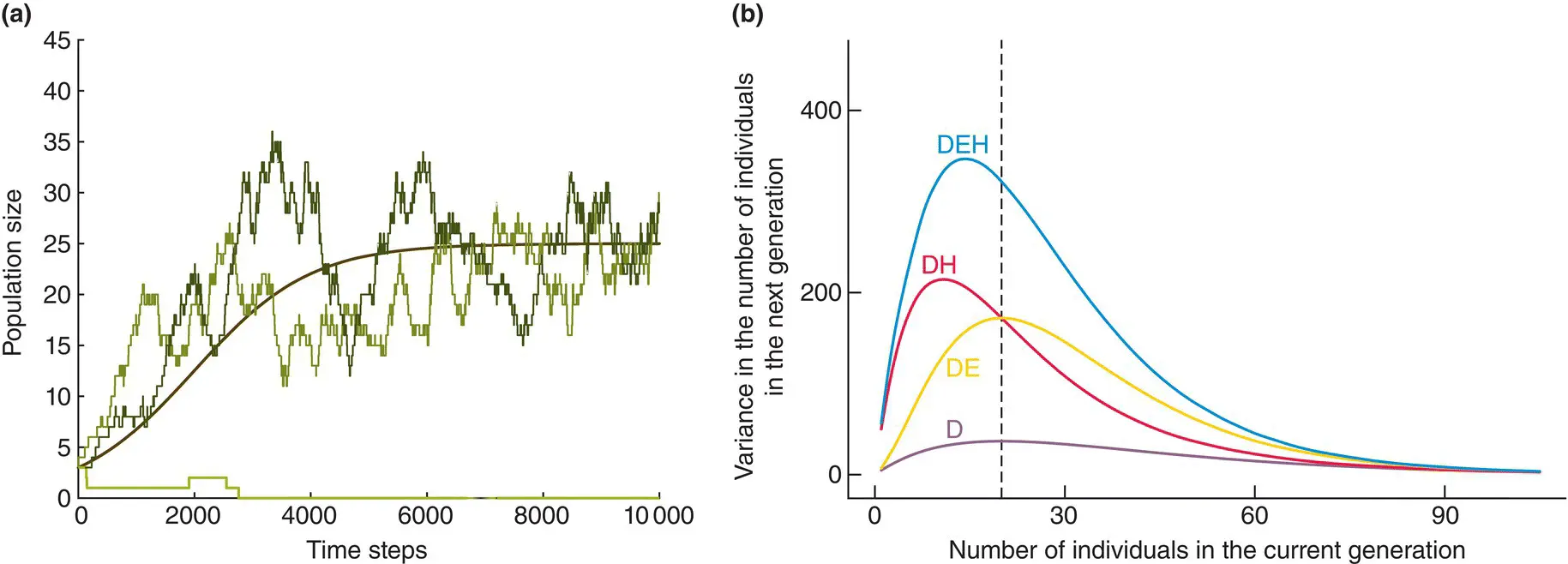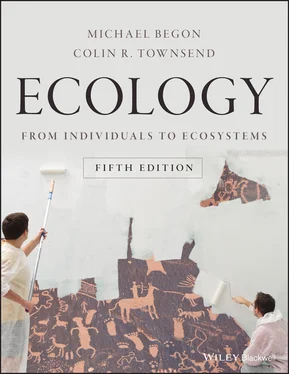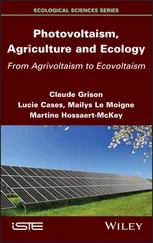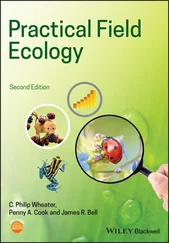We deal mostly with deterministic models throughout this book – because of their relative simplicity, and because for larger populations, the dynamics of deterministic and stochastic (or individual‐based) models are hard to distinguish. Note, nonetheless, that for smaller populations, those models can behave very differently. Figure 5.24a, for example, shows a population reflecting a deterministic model like that in Equation 5.12, with an initial size of 3 and a carrying capacity of 25, and therefore exhibiting S‐shaped growth as we saw in Figure 5.20a. Figure 5.24a also shows, however, three runs of an equivalent stochastic model. Two of those follow a similar path to their deterministic counterpart, albeit a more irregular one. But the third, far from approaching its notional carrying capacity, falls to extinction. The population, putting it colloquially, had a run of bad luck, but of course, such things do happen, whereas the population in the deterministic model is incapable of going extinct, or indeed of doing anything other than approaching its carrying capacity smoothly, and staying there.

Figure 5.24 Populations in stochastic models may have a high chance of going extinct even when their deterministic counterparts are incapable of doing so.(a) The smooth line is the output of a deterministic model of population growth regulated by intraspecific competition, initiated with a population size of 3 and with a carrying capacity of 25. The irregular lines are outputs of three runs of an equivalent stochastic model. (b) The variance in the number of individuals in the next generation as a function of the number in the current generation – an established proxy for the estimated time to population extinction – for various stochastic models of population growth regulated by intraspecific competition, as indicated. D has stochastic birth and death only. DE and DEH also have environmental stochasticity. DH and DEH also have individual heterogeneity in birth and death probabilities. The vertical dashed line marks the carrying capacity, 20. The greater the variance, the shorter the expected time to extinction.
Source : (a) After Allen & Allen (2003). (b) After Melbourne & Hastings (2008).
stochastic models of population extinction
These differences between the dynamics of deterministic and stochastic models are arguably most important when we are focused on small populations that we wish to conserve (reviewed by Ovaskainen & Meerson (2010)). Deterministic models of regulated population growth, taken at face value, would tell us that a population was safe from extinction, however small it was, as long as it had a finite carrying capacity and positive value of R . Believing this would be dangerously complacent. By contrast, stochastic models, going back to early studies (e.g. Leigh, 1981) have estimated expected times to extinction and found these to increase exponentially with carrying capacity. This reflects the reality than even in a world of stochastic birth and death rates, large populations have a negligible chance of going extinct, but for small populations, extinction within a given time window may be close to inevitable. Moreover, if we relax the assumption that the environment itself is stable, and acknowledge instead that there is likely also to be environmental stochasticity as well as, for example, heterogeneity amongst individuals in their birth and death probabilities, then these further compound the effects of demographic stochasticity, greatly reducing the expected times to extinction ( Figure 5.24b). We deal more fully with the conservation of small populations in Section 15.4.2, but it is clear that in order to judge the threats that they face, we shall often need to acknowledge all of the stochasticities affecting them, and to incorporate these into models that are themselves stochastic.
5.7 Continuous breeding: the logistic equation
The model derived and discussed in Section 5.6was appropriate for populations that have discrete breeding seasons and that can therefore be described by equations growing in discrete steps, i.e. by ‘difference’ equations. Such models are not appropriate, however, for those populations in which birth and death are continuous. These are best described by models of continuous growth, or ‘differential’ equations, which we consider next.
r , the intrinsic rate of natural increase
The net rate of increase of such a population will be denoted by d N /d t (referred to in speech as ‘d N by d t ’). This represents the ‘speed’ at which a population increases in size, N , as time, t , progresses. The increase in size of the whole population is the sum of the contributions of the various individuals within it. Thus, the average rate of increase per individual, or the ‘per capita rate of increase’ is given by d N /d t (1/ N ). But we have already seen in Section 4.7that in the absence of competition, this is the definition of the ‘intrinsic rate of natural increase’, r . Thus:
(5.19) 
and:
(5.20) 
A population increasing in size under the influence of Equation 5.20, with r > 0, is shown in Figure 5.25. Not surprisingly, there is unlimited, ‘exponential’ increase. In fact, Equation 5.20is the continuous form of the exponential difference Equation 5.8, and as discussed in Section 4.7, r is simply log e R . (Mathematically adept readers will see that Equation 5.20can be obtained by differentiating Equation 5.8.) R and r are clearly measures of the same commodity: ‘birth plus survival’ or ‘birth minus death’. The difference between R and r is merely a change of currency.

Figure 5.25 Exponential (solid line) and sigmoidal (dashed line) increase in density (N) with time for models of continuous breeding.The equation giving sigmoidal increase is the logistic equation.
the logistic equation
Intraspecific competition can be added to Equation 5.20by a method exactly equivalent to the one used in Figure 5.18b, giving rise to:
(5.21) 
This is known as the ‘logistic’ equation, and a population increasing in size under its influence is also shown in Figure 5.25.
The logistic equation is the continuous equivalent of Equation 5.12, and it therefore has all the essential characteristics of Equation 5.12, and all of its shortcomings. It describes a sigmoidal growth curve approaching a stable carrying capacity, but it is only one of many reasonable equations that do this. Its major advantage is its simplicity. Moreover, while it was possible to incorporate a range of competitive intensities into Equation 5.12, this is by no means easy with the logistic equation. The logistic is therefore doomed to be a model of perfectly compensating density dependence. Nevertheless, in spite of these limitations, the equation will be an integral component of models in Chapters 8and 10, and it has played a central role in the development of ecology.
Читать дальше

















